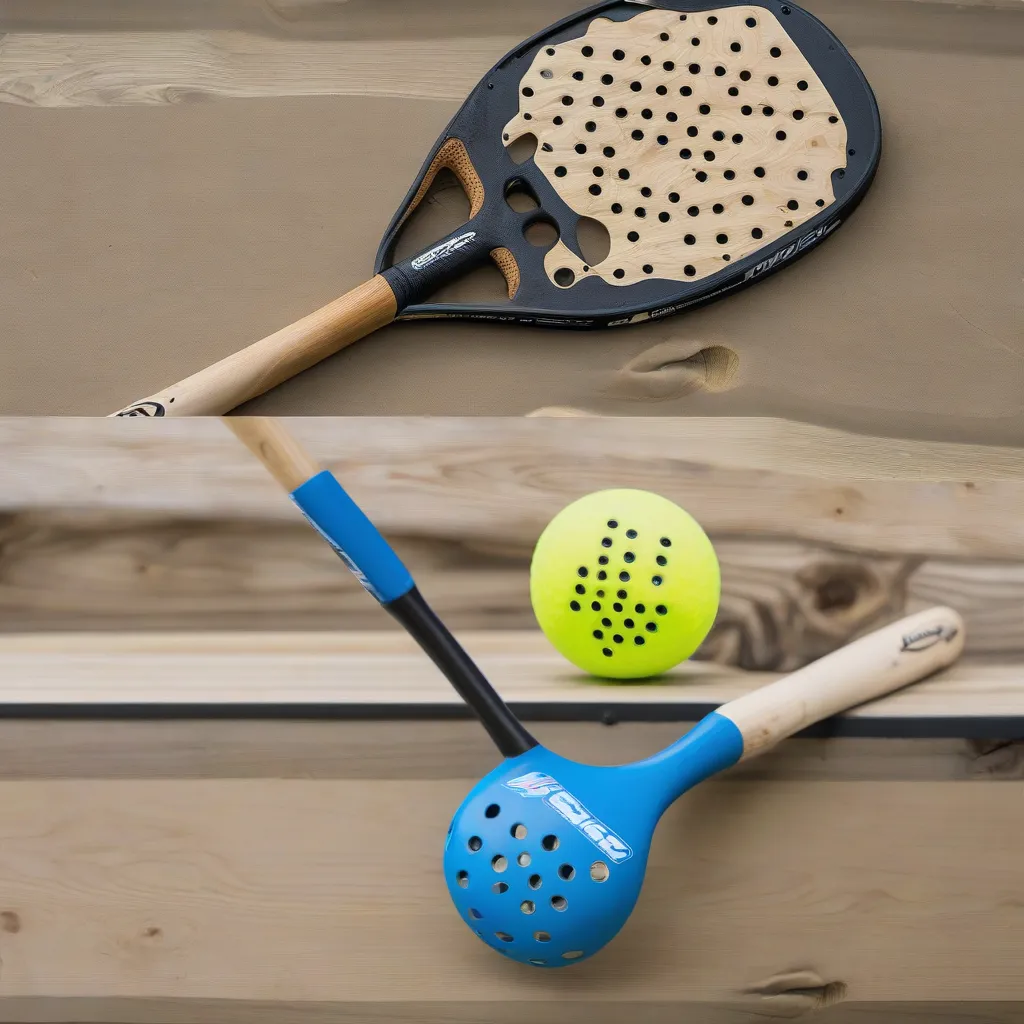Table of Contents
Introduction to Comparing Wood vs. Composite Pickleball Paddles
Choosing the right Pickleball paddle can significantly affect your game. Two popular types of paddles are wood and composite. Each has its own set of characteristics, advantages, and disadvantages. This ultimate guide will help you in comparing wood vs. composite Pickleball paddles by highlighting the 5 key differences, so you can make an informed decision that enhances your play.
Why the Choice Between Wood and Composite Matters
Your choice of Pickleball paddle can impact your performance, comfort, and overall experience on the court. Here’s why it matters:
- Performance: Different paddles affect your control, power, and spin.
- Comfort: The weight and feel of the paddle influence your comfort during play.
- Durability: Materials affect how long the paddle lasts and its resilience under pressure.
- Cost: The type of paddle you choose can impact your budget.
- Playing Style: Your playing style may be better suited to one type of paddle over another.
Understanding the differences between wood and composite paddles will help you select the best option for your needs.
 Wood vs Composite Pickleball Paddles Comparison
Wood vs Composite Pickleball Paddles Comparison
Top 5 Key Differences: Wood vs. Composite Pickleball Paddles
1. Material and Construction
Wood paddles are made from multiple layers of wood, making them heavy and durable. Composite paddles, on the other hand, are constructed from a combination of materials such as fiberglass, carbon fiber, and polymer cores, offering a balance of weight, durability, and performance.
2. Weight
One of the main differences when comparing wood vs. composite Pickleball paddles is weight. Wood paddles are generally heavier, which can provide more power but may cause fatigue during long games. Composite paddles are lighter, offering better maneuverability and control, which is preferred by many players.
3. Performance
Performance is a crucial factor when comparing wood vs. composite Pickleball paddles. Composite paddles are known for their superior performance, providing better control, spin, and power due to their advanced materials and construction. Wood paddles, while durable and powerful, do not offer the same level of performance enhancements.
4. Cost
Cost is another significant difference. Wood paddles are typically more affordable, making them a great choice for beginners or casual players. Composite paddles are more expensive but offer advanced features and performance benefits, making them a worthy investment for serious players.
5. Durability
Durability varies significantly between wood and composite paddles. Wood paddles are robust and can withstand heavy use, but they can splinter or crack over time. Composite paddles, made from advanced materials, tend to be more durable and resistant to wear and tear, although they may still get damaged from prolonged use or harsh impacts.
Choosing the Right Paddle for Your Playing Style
When comparing wood vs. composite Pickleball paddles, consider your playing style:
- Power Players: Wood paddles can provide the heft needed for powerful shots.
- Control and Spin Players: Composite paddles offer better control and spin, making them ideal for strategic play.
- All-Around Players: Composite paddles are versatile, offering a good balance of power, control, and spin.
- Beginner Players: Wood paddles are budget-friendly and durable, suitable for learning the game.
By understanding your playing style, you can choose a paddle that enhances your strengths and improves your overall game.
Common Mistakes When Choosing a Pickleball Paddle
Here are some common mistakes to avoid when comparing wood vs. composite Pickleball paddles:
- Ignoring Weight: Choosing a paddle that is too heavy or too light for your play style can negatively impact your performance.
- Overlooking Grip Size: A proper grip size is essential for control and comfort. Make sure to select a paddle with a grip that fits your hand size.
- Focusing Only on Cost: While budget is important, consider the paddle’s performance features and how they suit your play style.
- Neglecting Durability: Choose a paddle that can withstand the intensity of your play without easily getting damaged.
- Not Testing the Paddle: If possible, test different paddles to find one that feels right and enhances your game.
Avoiding these mistakes will help you make a better-informed choice and improve your performance on the court.
Resources for Further Learning
To continue improving your Pickleball skills and knowledge, check out these valuable resources:
Conclusion
Comparing wood vs. composite Pickleball paddles reveals significant differences in material, weight, performance, cost, and durability. Your choice should be guided by your playing style, budget, and personal preferences. By considering the key differences and avoiding common mistakes, you can choose the perfect paddle that enhances your game and brings you more success on the court. Use the resources provided to deepen your understanding and continue improving your Pickleball skills.
Frequently Asked Questions
- What are the main differences between wood and composite Pickleball paddles? Wood paddles are heavier and more affordable, while composite paddles are lighter, offer better performance, and are more expensive.
- Which type of paddle is better for beginners? Wood paddles are budget-friendly and durable, making them a good choice for beginners learning the game.
- How does the weight of the paddle affect play? Heavier paddles provide more power but can cause fatigue, while lighter paddles offer better control and maneuverability.
- Are composite paddles worth the extra cost? Yes, composite paddles offer advanced features, better performance, and durability, making them a worthwhile investment for serious players.
- What should I consider when choosing a Pickleball paddle? Consider factors such as weight, grip size, material, shape, core, and your playing style to find the paddle that best suits your needs.
- Where can I find more information on Pickleball paddles? Check out resources from the USA Pickleball Association, Pickleball Central, Pickleball Portal, and PickleballMAX for valuable tips and reviews.